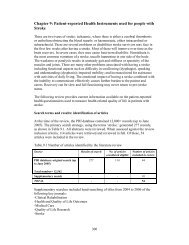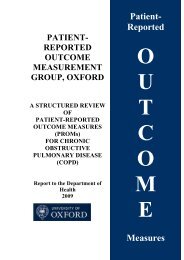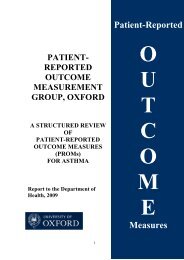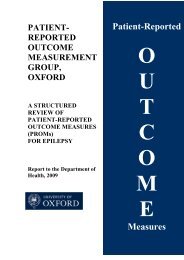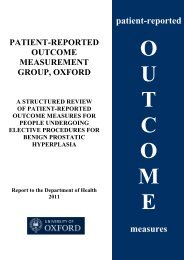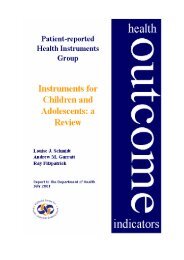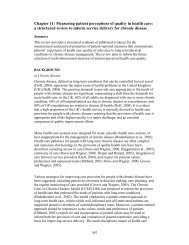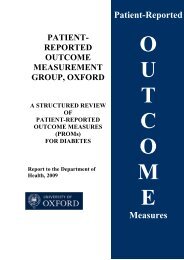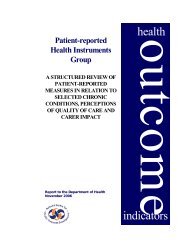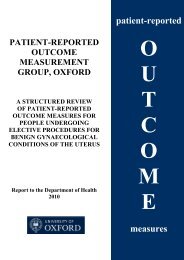2010 review - Patient-Reported Outcomes Measurement - University ...
2010 review - Patient-Reported Outcomes Measurement - University ...
2010 review - Patient-Reported Outcomes Measurement - University ...
You also want an ePaper? Increase the reach of your titles
YUMPU automatically turns print PDFs into web optimized ePapers that Google loves.
(2009), with women having significantly poorer pre- and post-operative functional status,<br />
independently of age.<br />
Responsiveness of the SF-12 was supported in the study by Barnett and colleagues (<strong>2010</strong>),<br />
with statistically significant score improvements in all domains at one year, for all BMI<br />
groups. Another study of CABG patients showed significant improvements at three months<br />
compared with baseline in both MCS and PCS (Sandau et al., 2008).<br />
Acceptability and feasibility of the SF-12 as part of a survey package for the routine<br />
collection of baseline data on patients undergoing CABG or PCI were explored in a study by<br />
Spertus and colleagues (2001), with mixed results. Although the survey was acceptable to the<br />
majority of patients (92% agreed to participate), it proved difficult to convince nursing staff<br />
to integrate such data collection into routine care.<br />
f. Sickness Impact Profile (Bergner et al., 1976; Bergner et al., 1981)<br />
The Sickness Impact Profile (SIP) was developed in the USA to provide a broad measure of<br />
self-assessed health-related behaviour. It was intended to inform policy decision-making.<br />
Instrument content was based on the concept of ‘sickness’, defined as reflecting the change in<br />
an individual’s activities of daily life, emotional status, and attitude as a result of ill-health<br />
(McDowell and Newell, 1996). Items were derived from literature <strong>review</strong>s and statements<br />
from health professionals, carers, patient groups, and healthy subjects describing change in<br />
behaviour as a result of illness. The SIP comprises 136 items across 12 domains: Alertness<br />
Behaviour (AB), ambulation (A), Body Care and Movement (BCM), Communication (C),<br />
Eating (E), Emotional Behaviour (EB), Home Management (HM), Mobility (M), Recreation<br />
and Pastimes (RP), Sleep and Rest (SR), Social Interaction (SI), and Work (W).<br />
Each item is a statement; those that best describe a respondent’s perceived health state on that<br />
day are ticked; items are weighted, with higher weights representing increased impairment.<br />
An overall percentage score can be calculated for the total SIP or for each domain, where 0 is<br />
better health and 100 is worse health. Two summary scores are calculated: Physical function<br />
(SIP-PhysF), comprising A, BCM, and M, and psychosocial function (SIP-PsychF),<br />
comprising AB, C, EB, and SI; the five remaining categories are scored independently. The<br />
developers state that subscales can be administered separately without compromising<br />
reliability or construct validity (Bergner, 1978). The instrument may be self- or interviewadministered.<br />
Four studies were identified which evaluated the SIP with patients undergoing CABG; all<br />
were US samples. No recent studies were identified.<br />
Internal consistency of a combination of six SIP subscales applied in a study of perceptions<br />
of QoL at one year post-CABG was good, with a Cronbach’s alpha of 0.86 (King et al.,<br />
1992). A slightly different set of subscales was used in two studies examining age and sex<br />
differences in patterns of recovery post-CABG; internal consistency was low to acceptable,<br />
with Cronbach’s alphas ranging 0.53 (RP) to 0.81 (BCM) (Artinian et al., 1993, 1995). The<br />
authors note that these relatively low values (except for the BCM subscale) signify that<br />
results should be interpreted with caution (Artinian et al., 1993, 1995).<br />
Construct validity of the SIP was supported in a study of psychosocial predictors of postoperative<br />
recovery, where SIP was used as the criterion measure, by strong correlations of<br />
20



